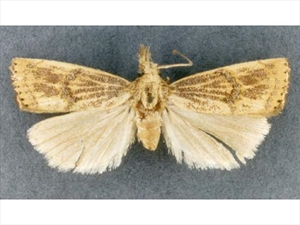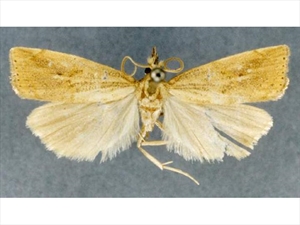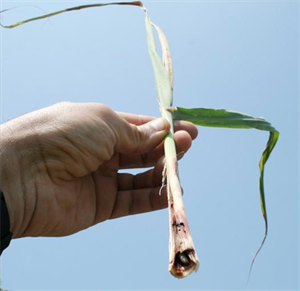Rice gold-fringed borer
Pacific Pests, Pathogens, Weeds & Pesticides - Online edition
Pacific Pests, Pathogens, Weeds & Pesticides
Rice gold-fringed borer (410)
Chilo auricilius. Another species, Chilo suppressalis (the Asiatic stem borer, or striped stem borer), occurs in Australia, but not in the rest of Oceania. It is also similar to Chilo polychrysus, which occurs in India, Indonesia and Thailand. A moth of the Crambidae.
South and Southeast Asia, Oceania. It is recorded from Papua New Guinea.
Rice, sugarcane, sorghum, maize, and wild grasses.
The larvae do the damage by feeding on the stems and causing similar symptoms to other rice stem borers (see Fact Sheets nos. 408, 409, 411). The larvae tunnel into the stems, through the internodes towards the base of the plant, causing stems to wilt and die, a condition known as 'deadheart'. The stems are easily pulled out (Photo 3). Feeding at the base of the panicles may prevent emergence or result in white unfilled grain of those that have emerged, a symptom called 'whitehead' (Photo 4).
Eggs are creamy-white, slightly flattened, scale-like, laid in 2-5 rows; they turn black later. Larvae are white, growing to 25-30 mm long with five bluish-purple lines along body, and brown heads. Female pupae are 13-14 mm, males slightly shorter, and they are brown. Adult forewings yellowish or brownish with silvery dots and a marginal golden fringe; hindwings are light brown (Photos 1&2). The moth is nocturnal.
The gold-fringed rice borer is considered to be primarily a pest of sugarcane, and only attacks rice occasionally. Another species, the striped stem borer, Chilo suppessalis, is considered to be a far more important species on rice, known to destroy entire fields (see Fact Sheet no. 410).
Look for deadhearts and whiteheads at the vegetative and flowering stages, respectively. Because of similarity with other Chilo species attacking rice, identifications should be done by taxonomists with expertise in the Lepidopteran pests of rice.
BIOSECURITY
Countries not yet infested by the gold-fringed stem borer should consider all likely pathways for entry, and apply quarantine measures accordingly. Many countries throughout Asia, Africa, the Americas and Oceania are at risk. Pathways of introduction are likely to be via produce contaminated by pieces of stem of the hosts infested with larvae or pupae.
NATURAL ENEMIES
In general, the gold-fringed rice borer is parasitised and predated by the same natural enemies as other rice stem borers. In India, the tachnid fly, Stumiopsis inferens, and the wasp, Pycycnobracon mutator, are useful larval parasites, and Trichogramma japonicum and a Telenomus sp. the most effective egg parasioids.
CULTURAL CONTROL
Chilo auricilius usually occurs with other rice stem borers, e.g., Scirpophaga and Sesamia species and is controlled by the same measures applied to them.
Before planting:
- Prepare the land thoroughly ensuring vigorous plant growth when planted, and to destroy larvae and pupae from a previous crop.
- Plant at high density to compensate for damage that may occur.
- Rotate rice with non-host crops, e.g., legumes.
During growth:
- Try to synchronise planting in any area so that crops do not overlap, to prevent pest populations moving from harvested to standing crops.
- If irrigating, raise the level of the water from time to time to submerge the eggs on the lower parts of the plant.
- If the crop is seasonal, plant early.
- Weed as soon as required to promote good crop growth.
- Cut out the stems with deadhearts and remove from the field. Destroy the larva or burn the stalk. Note this is labour intensive and not very effective as the pest may already have left.
- Apply nitrogen fertilizer in split applications: check local recommendations for rates and timing.
After harvest:
- Harvest crops at ground level to remove the larvae in the stubble.
- Plough remaining rice stubble into the soil to kill larvae and pupae, and avoid leaving unharvested plants. Alternatively, irrigate the field, if that is possible.
- Remove or plough in weeds (grasses and sedges), which may be alternative hosts.
RESISTANT VARIETIES
Modern rice varieties that are relatively thin-stemmed, short, high tillering, and early maturing, may result in less damage from stem borers generally. This aspect is important as well-grown, vigorous crops can withstand 20% deadhearts and 10% whiteheads before yield is affected.
CHEMICAL CONTROL
As the stem borer is thought to be a minor rice pest, chemical control is likely to be unnecessary. There is also the risk of destroying natural enemies if it is used. If chemicals are needed:
- Use abamectin, a natural fermentation product from a bacterium.
- In Fiji, diazinon and bifenthrin are recommended for (unspecified) stem borers.
- Chlorpyrifos and fipronil, have also been recommended (for all stem borers), but note that chlorpyrifos is an organophosphate insecticide, and is a potent nerve agent; the World Health Organization (WHO) considers chlorpyrifos to be moderately hazardous (Class II). The use of fipronil is under review in Australia by the APVMA because of environmental concerns. A report is expected in 2020. Reviews on the use of chlorpyrifos are on-going in Europe, USA and Australia.
- All synthetic products are likely to reduce the impact of natural predators and parasitoids against this moth, and can only be recommended as a last resort.
____________________
When using a pesticide, always wear protective clothing and follow the instructions on the product label, such as dosage, timing of application, and pre-harvest interval. Recommendations will vary with the crop and system of cultivation. Expert advice on the most appropriate pesticide to use should always be sought from local agricultural authorities.
AUTHOR Grahame Jackson
Information (and Photo 4) from Rice Knowledge Bank. IRRI. (http://www.knowledgebank.irri.org/training/fact-sheets/pest-management/insects/item/stem-borer); and CABI (2017) Chilo auricilius (gold-fringed rice borer). Crop Protection Compendium. (https://www.cabi.org/cpc/datasheet/18759); and (including Photo 3) Anderson S, Tran-Nguyen L (2012) Gold-fringed Rice Borer (Chilo auricilius). (Source: N. Sallam DAFF Biosecurity.) PaDIL - (http://www.padil.gov.au); and from Chilo auricilius. Wikipedia. (https://en.wikipedia.org/wiki/Chilo_auricilius).
Produced with support from the Australian Centre for International Agricultural Research under project HORT/2016/185: Responding to emerging pest and disease threats to horticulture in the Pacific islands, implemented by the University of Queensland and the Secretariat of the Pacific Community.







